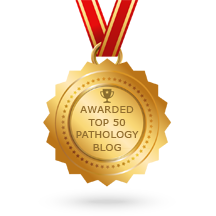In histologic sections, the eggs are typically seen in various stages of degeneration and calcification. Here, some degenerating nuclei are present within the egg (H&E, 1000x).
+answer2.jpg)
To make a diagnosis to the species level, you need to see a clearly identifiable terminal spine. The spines of these eggs are fairly clear (arrows):
+answer.jpg)
and are even more pronounced in this image from a separate case:
+answer3.jpg)
When urinary schistosomiasis is suspected, examination of urine for characteristic eggs is a non-invasive way to make the diagnosis.



No comments:
Post a Comment